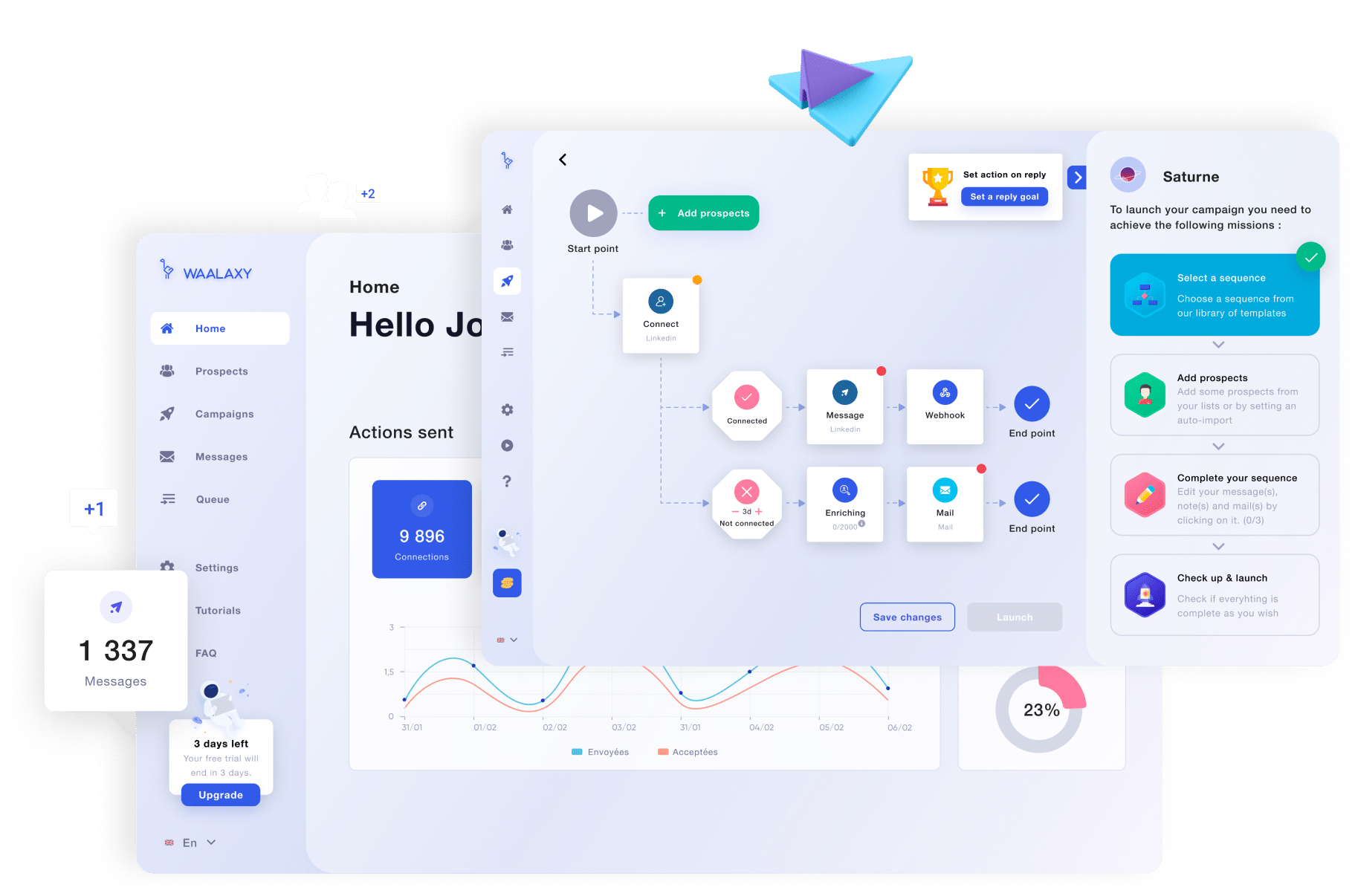Today, we’re going to explain how you can use the ChatGPT prompts for blogging to transform your content strategies.
As you surely know, the world of SEO is constantly evolving, and integrating artificial intelligence can benefit you. 🔥
Contents:
- Why use ChatGPT prompts for blogging ?
- 50 prompts to help you optimize your content.
- The limits of ChatGPT.
Sit back, enjoy a cup of tea and off you go! 🚀
Why use ChatGPT prompts for blogging ?
If you don’t know what ChatGPT is, it’s an artificial intelligence that can quickly generate high-quality content that can be optimized for search engines. 👀
In fact, thanks to its inspection skills, it can optimize every aspect of your content while maintaining a high level of user engagement. Don’t worry, we’ll show you plenty of examples below. 😇
But that’s not all: let’s take a closer look at why we recommend using it. ⬇️
1) Find topics and new ideas
Thanks to ChatGPT’s advanced capabilities, you can analyze :
- Current trends.
- User preferences.
- Ongoing discussions.
The aim? Identify 🔎 new, relevant and original content.
Okay, but how does he do it? 🤔
This AI starts by analyzing a set of data, which allows you to stay up to date with the latest trends but also, to anticipate the needs and questions of your audience.
The more relevant and targeted content ideas you provide, the more ChatGPT can help you create optimized content that attracts 🧲 attention and is search engine friendly.
Basically, if you integrate ChatGPT into your creative process, you’ll have a brain capable of renewing and diversifying your production ad infinitum ♾️.
This keeps content dynamic and engaging, which is essential for good positioning in search results.
2) Help with structure and drafting
I’m not telling you anything new, but optimizing content structure and writing is essential to improve user engagement and search engine rankings.
This artificial intelligence therefore not only generates content ideas, but also proposes detailed plans that improve readability and interaction with readers. 👀
Indeed, ChatGPT can offer attention-grabbing titles and subtitles that are, above all, optimized with SEO-relevant keywords. 🚀
The better your article is structured and readable, the more the reader will remain engaged throughout the article, thus reducing the bounce rate and increasing the time spent on the page.
If we’re talking purely about copywriting, the latter can formulate fluid, natural sentences, and can add important keywords subtly, without distorting the quality of the text.
And a little extra that I love is the ability to vary the writing style to tailor content to different target audiences. 🥰
Finally, ChatGPT can go over your text again, correcting unnecessary repetitions or grammatical errors.
As you can see, using ChatGPT can improve your copywriting overall. 😏
50 ChatGPT prompts for blogging
Okay, now that you’ve seen the value of using ChatGPT at work for your blogging strategy, you need to know how to talk to it.
To do this, we use a prompt, a phrase written by the user to start a conversation with ChatGPT. ⌨️
And now, just for your viewing pleasure 👀, discover 50 prompts ideas for blogging. 😇
1) Find topics to talk about
Sometimes you can stagnate in your search for the nugget topic to tackle. ✨
Then you can ask ChatGPT:
Prompt n°1 = “What are the new trends in [insert sector or area of interest] for the next 12 months?”

Prompt n°2 = “What are the questions most frequently asked by users about [insert topic or product]?”

2) Generate keywords
Sometimes, you may run out of keyword ideas. In that case, don’t hesitate to ask ChatGPT!
Prompt n°1 = “Generate a list of keywords for [insert your topic or product].”

Prompt n°2 = “What keywords are my competitors using for subject [insert subject]?”

3) Generate long tail
Keywords are great, but sometimes wanting to rank on them can be difficult, as the keyword can be very competitive. 👀
In this case, opt for long trails with less volume to try and position yourself. 😇
Prompt n°1 = “Generate a list of long tail keywords for [insert your topic or product].”

4) List of keywords according to search intent
Now let’s go into a little more detail and try to find prompts according to search intent. 👀
Prompt n°1 = “You’ve been an SEO expert for over 10 years. Generate a list of informative keywords for users looking to understand [insert topic or issue].”

Prompt n°2 = “As an SEO expert, make a list of transactional keywords for users interested in purchasing [insert product or service].”

5) Translate your keywords into other languages
Sometimes you need to find and write articles in other languages, particularly Spanish. To make your research easier, you can ask ChatGPT to translate those famous keywords! 👀
n°1 = “Translate these keywords into [target language]: [list of keywords].”

n°2 = “Provide equivalents in [target language] for these keywords, taking into account the cultural context and local specificities: [list of keywords].”

6) Find questions about a topic
Some articles include frequently asked questions. If the search engine results aren’t conclusive, you can ask artificial intelligence to find questions for you. Here are a few examples! ⬇️
Prompt n°1 = “Based on your SEO knowledge, find the most frequently asked questions about [insert topic or problem].”

Prompt n°2 = “Identify the most common problems or challenges related to [insert topic or problem]”.

7) Generate a list of topics
Sometimes you can run out of ideas, especially if you’ve scoured 🌽 every communication and marketing site. This is where our friend ChatGPT comes in.
Prompt n°1 = “As an SEO expert, explore emerging trends in [insert industry], then generate a list of topics anticipating readers’ future needs.”

Prompt n°2 = “Analyze recent discussions on social networks and forums in then generate topics that are already attracting interest from the online community.”

8) Request article structure
You may sometimes run out of ideas for the structure of your article. ChatGPT has more than one trick up its sleeve. 🪄
Prompt n°1 = “As an SEO expert, develop an outline for an article that talks about [topic], adding pros and cons, steps to implement it, some tips, a conclusion and frequently asked questions.”

Prompt n°2 = “Create the structure of an article about [topic]. Use H1,H2,H3 headings.”

9) Find a meta-description
Running out of meta-descriptions? If you choose your prompt carefully, this artificial intelligence may surprise you. Let’s test a few queries together! 👇🏼
Prompt n°1 = “Develop a powerful meta web page description for [insert topic], using targeted keywords and capturing the attention of the target audience from the very first words, in an engaging and understandable tone.”

Prompt n°2 = “Create an SEO-optimized meta description blog post for one on [insert topic], highlighting the target query “[set query]”, the unique benefits of the content and prompting action in a concise and persuasive manner, not to exceed 160 words.”

10) Find a catchy title
This goes hand in hand with the meta-description, finding a title that strikes a chord with your target audience can take time. ⏰ And I’m not telling you anything, it’s important to have a good title, it’s what makes the reader want to click on your article and not that of a direct or indirect competitor! 👀
If you’re short of inspiration, you can try this.👇🏼
Prompt n°1 = “Generate a punchy headline for an article on [insert topic], captivating the target audience’s attention and prompting them to read the entire content.”

Prompt n°2 = “Come up with a catchy headline for a blog post that talks about [insert topic], in an engaging tone, with x number of steps to make the reader want to click.”

11) Generate frequently asked questions
We recommend that you end your article with a few questions. Why do we do this? Well, frequently asked questions answer any further questions the reader may have. It anticipates future needs and brings the article to a close. 😄
Prompt n°1 = “Identify the most frequently asked questions about [insert your topic] and suggest 3 questions for me.”

Prompt n°2 = “After analyzing competing articles and user responses on [insert topic], suggest 2 questions I can add to my article’s frequently asked questions.”

12) Find a list of arguments
Before you take a stand on a subject, you need to make a list of convincing arguments. ✨
You can ask ChatGPT to do it for you! 👇🏼
Prompt n°1 = “Based on [insert topic], come up with a list of arguments that allow you to analyze the situation.”

Prompt n°2 = “After doing a competitor analysis on [insert topic], makes a list of 5 arguments.”

13) List advantages and disadvantages
Sometimes, depending on the subject, you may need to define a list of advantages and disadvantages to help the reader make a choice. You can do this in the form of a bulleted list or a table. 😇
Here are a few prompts to help you:
Prompt n°1 = “By doing an in-depth analysis on [insert subject], highlights the positive and negative points, then makes an exhaustive list of advantages and disadvantages”.

Prompt n°2 = “You’ve been an SEO expert for more than 10. Based on your knowledge, propose to me in table form a list of the advantages and disadvantages of [insert subject].”

14) Tabulate the list
I recommend using tables in your articles, as it’s more airy and pleasant to read. Instead of wasting time on Google Sheets, you can ask ChatGPT to create a table for you. 👇🏼
Prompt n°1 = “Organize this list [insert list] using columns to categorize the various items and rows to detail each item.”

Prompt n°2 = Structure this list [insert list] as a table, highlighting key elements in one column, and adding detailed descriptions in another column.”
15) Write the copywriting brief
You may be handing over the job of writing your articles. In this case, you’ll need to draw up an editorial brief.
Let’s take a look at some examples of prompts: 👇🏼
Prompt n°1 = “Write a detailed brief for the editorial writer, highlighting the objectives of the article, the key points to be addressed, and stressing the importance of consistency with the brand line.”

Prompt n°2 = “Prepare a full briefing for the copywriter, including information on the target audience, keywords to incorporate, and instructions on the structure and format of the article to ensure its effectiveness, in 400 words.”

16) Generate content summary
Would you like to shorten a 1,000-word text down to 300 words? No problem, this AI for your content strategy can do it for you. 👇🏼
Prompt = “Shorten this text to 300 words [insert text].”

17) Add keywords to a text
When you’re writing an SEO article, you know how important keywords are. But sometimes you don’t know exactly where to add your keywords. Don’t panic, with this prompt, your worries are erased 💨.
Prompt = “In this text [insert text], add the following keywords [insert keywords], respecting the form and meaning of the text.”
Here is the original text:
Content marketing is the creation, distribution and promotion of relevant and valuable content to attract, engage and retain a target audience. It’s a marketing strategy focused on building lasting relationships by offering informative, entertaining or inspiring content tailored to the audience’s needs and interests.
Here’s his answer. 👇🏼

18) Bold certain keywords
Putting certain words in bold highlights important keywords for both Google and your readers. You can either do this yourself, but it’s likely to be time-consuming. 🙃
Alternatively, you can ask ChatGPT via this prompt:
- Prompt = In this text [insert text], bold the SEO keywords you think are relevant.”

19) Ask for a rewrite
Do you have a text you’d like to edit, but don’t know how to rephrase it? Don’t panic, ChatGPT is there for you. You can use these prompts! 👇🏼
Prompt n°1 = “Reformulate the following text [insert text] solely for a btob target and start the text with a captivating and attractive sentence that will appeal to the target”.

Prompt n°2 = “Rewrite this text [insert text] in a more engaging tone, in no more than 200 words”.

20) Check the internal mesh
You’re a human being, not a robot, so you can’t necessarily think of everything at the same time, especially if you have to write, make your visuals, take care of optimization and meshing.
ChatGPT can help you with this task, provided you use it with care and check ChatGPT’s sources! ⬇️
Prompt n°1 = “Can you identify and evaluate the internal links present in this blog post [insert article link]? I’d like to know if they’re relevant to the content discussed and if they could be optimized to improve SEO and reader engagement.”

Prompt n°2 = “Can you review the internal links in this article [insert article link] to determine their effectiveness in terms of navigation and thematic relevance?”.

21) Optimize item size
Depending on the theme of your topic, the length of your article may be important.
That’s why you can use ChatGPT to optimize article size. Here’s how! ⬇️
Prompt n°1 = “Can you look at the length of the articles on my blog and advise me on the ideal size to improve SEO rankings? I’d like to know if longer or shorter articles would be more beneficial for my specific content.”

Prompt n°2 = “Can you analyze some of my articles to assess whether content length and keyword density are optimal for blogging? I’m looking to maximize visibility while maintaining high content quality.”
22) Generate optimized captions (alt tags) for your images
When you write an article, we advise you to add a few images in order to rank on Google. 😌
However, you need to fill in certain information on these images, such as the alt tag or caption.
Here are a few ideas for prompts. ⬇️
Prompt n°1 = “Suggest an alt tag for an image related to [insert subject].“

Prompt n°2 = “I have an image I’d like to add to my article that looks like [insert image details]. With this information, suggest an alt tag and a suitable caption.”

23) Optimize your URLs for search engine optimization
Just like the blogging, you must optimize your URL ! This is why ChatGPT can help you when you don’t know how to do or have no ideas. 😇
Prompt n°1 = “Optimize this URL [insert the URL] with simplified structure and primary keywords.“

Prompt n°2 = “Can you optimize this URL [insert the URL] to comply with SEO standards and rank higher on Google?”

24) Optimize your Google Business profile
when you’re looking for your favorite restaurant, you’re going to dig into the reviews on the restaurant’s Google My Business page, aren’t you? 👀
Well, here it’s the same. It’s important that your GMB is optimized if you want good results (pshiit, you can optimize it with the help of Google Ads). 💟
Prompt n°1 = “Here’s my google my business page (insert google my business URL), suggest areas for improvement”.

Prompt n°2 = “I’m an SEO agency. Suggest me some improvements for a Google My Business page.“

25) Correct spelling mistakes
A careless mistake can happen quickly, especially when you want to write quickly. 😅
That’s why we recommend that you start by using proofreading tools such as LanguageTool or Grammarly.
Let’s discover some prompts for blogging.
Prompt n°1 = “You’ve been an SEO and spelling expert for over 10 years. Correct this text [insert the text] according to blogging and SEO rules.“

Prompt n°2 = “I think I’ve made a few careless spelling mistakes in this text [insert the text]. Correct it for me.”

3 ChatGPT limitations to consider for your blogging
Sure, ChatGPT can be useful for your content, but this tool has its limits. Yes yes, you heard me right, ChatGPT, or any other artificial intelligence tool, has limits. 👀
That’s what we’re going to find out right now. 👇🏼
1) A robot does not replace a human being
Be aware that no algorithm can completely replace human judgment.
Despite ChatGPT’s impressive ability to generate coherent, relevant content, it often lacks nuance and sensitivity, something a copywriter can totally provide. 💟
And, as you know, blogging isn’t just about producing optimized content, it’s also about engaging with the target audience, creating a relationship of trust and answering the user’s various questions.
It’s important not to overlook the role of copywriters in creating an effective blogging strategy.
2) ChatGPT is not fully up to date
I think you already know this, but ChatGPT is only up to date until April 2023. This can be complicated if you want detailed information on a certain topic. 🤔
Okay, but how do I do it? 😅
Well, the old way. How did you do it before ChatGPT existed? You used Google! Well, it’s the same here.
As soon as this artificial intelligence sends you a piece of information, I strongly advise you to check its accuracy. ℹ️
3) ChatGPT is identifiable by Google
If you’re using artificial intelligence to create web content, make sure it’s recognized by search engines like Google.
Indeed, when text generated by ChatGPT is used directly on websites without any modification, it can be identified 🔎 as “robot” by Google’s algorithms.
This is mainly due to redundancies in sentence structuring and the use of a certain vocabulary. 👀
If AI-generated content is detected and judged as unoriginal or repetitive, this could negatively affect the site’s ranking in search results.
How about a recap?
As you will have understood, achieving a good ChatGPT prompts for blogging is not just a question of keywords but, but a whole process in which you need to think about :
- Clear objectives.
- Content specificity.
- The adapted structure of the text.
- Integrate relevant context.
By respecting this, you’ll be able to produce content that meets search engine requirements but, above all, engages your readers! 💟
There are other ways to help you with your content and prospecting strategy. Click on the button to discover others👇🏼.
Frequently asked questions
Hop hop hop, don’t rush off, we’ve still got a few questions to answer! 👇🏼
How to formulate effective prompts for blogging ?
Knowing how to talk to ChatGPT is an art 🖼️ that needs to be learned. Here are our tips for optimizing your prompt creation:
- 1️⃣ Clearly define the objective.
- 2️⃣ Use relevant keywords.
- 3️⃣ Be specific and detailed.
- 4️⃣ Include background information.
- 5️⃣ Specify the desired structure.
What kind of blogging content can ChatGPT create?
ChatGPT can create many types of content to enhance your content marketing strategy, here are just a few examples:
- 🟣 Blog posts.
- 🔵 Product descriptions.
- 🟣 Web page content.
- 🔵 Frequently asked questions.
- 🟣 Guide and tutorials.
- 🔵 Social media posts.
- 🟣 Newsletter content.
- 🔵 Meta descriptions and SEO titles.
And now you know how to create your best ChatGPT prompts for blogging. See you soon! 🐉








